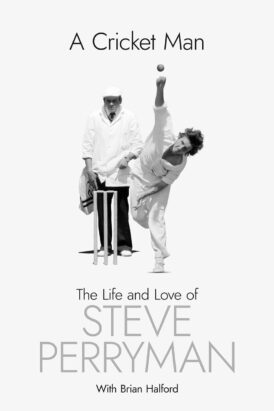A Cricket Man
Martin Chandler |Published: 2024
Pages: 238
Author: Halford, Brian and Perryman, Steve
Publisher: Pitch
Rating: 4 stars

Back in the 1970s there were two Steve Perrymans, one who was a footballer and the other a cricketer. The midfielder who made 655 appearances for Spurs was by far the better known of the two. My late father, who had that sort of a sense of humour, much enjoyed asserting that the Steve Perryman who bowled right arm medium fast for Warwickshire, if he ever wrote an autobiography, could call it ‘The Other Steve Perryman’.
Half a century on I opened this one with that pleasant memory of my Dad coursing through my mind, and thinking how he would have feigned disgust and disappointment on discovering that his advice had been ignored. Having got to the end of this immensely readable book I would, however, have to concede that A Cricket Man is actually the perfect title for this one, which is the main point made by Chris Woakes in an excellent foreword, which despite being all about Perryman says a great deal about Woakes as well.
Perryman was a man with who had a short and in many ways back to front career. He made his First Class debut for Warwickshire at 18 in 1974, but did not bowl in the single match that he was selected for. He then got an unexpected chance right at the start of the following summer and kept his place for the rest of the season before, in 1976, having the best season of his career, until a knee injury in July cut it short.
At this point I had already realised that Perryman was to leave the First Class game at 28 and, being a seam bowler, assumed it would be injury that brought about the premature end. In fact it wasn’t. The Perryman who came back to Edgbaston in 1977 was pretty good too, and he carried his decent form into 1978 and 1979 as well, but it was after that that the decline set in. There were then two disappointing years with the Bears, followed by two more at Worcester after which the county game was no longer interested in Steve Perryman.
Being no speedster the youthful Perryman relied for his wickets on accuracy and an ability to swing the ball both ways in order to trouble batsman. His loss of effectiveness happened because well meaning coaches tried to change his action, the only real effect of which was to take away his ability to move the ball away from the right handed batsman, and no matter what he tried he was unable to get that back.
The early part of A Cricket Man tells the far from unusual story of a how a sports mad youngster grew up in Birmingham in the 1960s and how, with the help and sacrifices of his family, he was able to realise his dream of joining the staff at Edgbaston. There is nothing particularly remarkable about that rise, so it must be credit to writer Halford that the story is told in such an engaging way, although Perryman’s modesty and occasionally self-deprecating style helps as well.
The era in which Perryman played was not a great one for his county, but for the county game generally it was, most of the finest players in the world turning out day after day in the Championship. His observations on the repercussions of the World Series Cricket schism in the Edgbaston dressing room are interesting, but above all what comes through from A Cricket Man is that Perryman greatly enjoyed his county career, despite his travails in the last few years.
After his county career ended Perryman moved into coaching, something else that by and large he seems to have derived great pleasure and satisfaction from, especially when he got back to Edgbaston and played a role in the development of men like Ashley Giles, Moeen Ali and Woakes. He also talks about his personal life, and the loss of a beloved second wife to cancer at the same time as that exact fate befell Halford as well, but the positivity that characterises the man remains, and never less than when writing about, as he frequently does, his beloved Birmingham City.
The fact that A Cricket Life is the sort of cricketer’s story that seldom interests publishers is doubtless part of the reason why it is an engrossing read, but in addition to that it is well written and nicely produced with an interesting selection of photographs. There are some interesting reflections in the closing chapters as well, which really ought to get Perryman some media work, if he’s interested of course!






Leave a comment